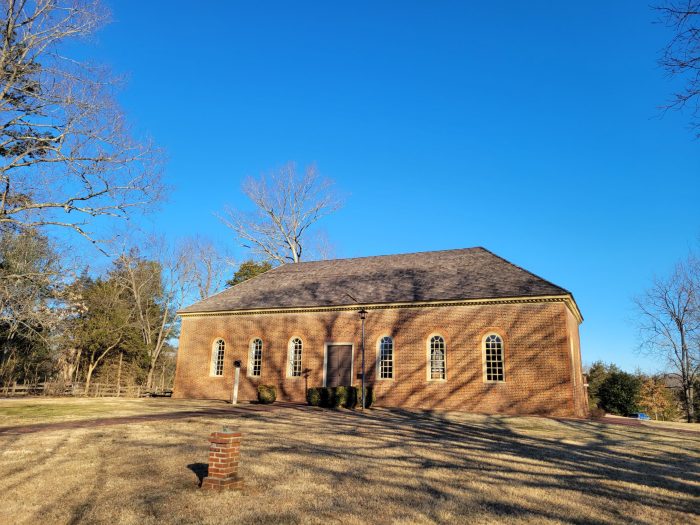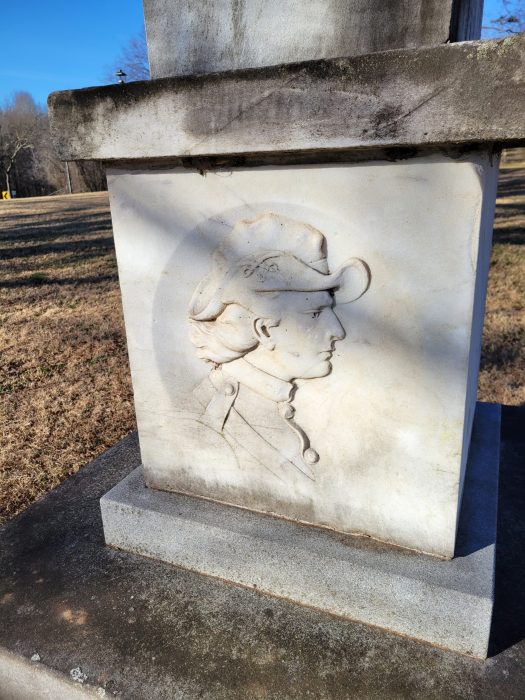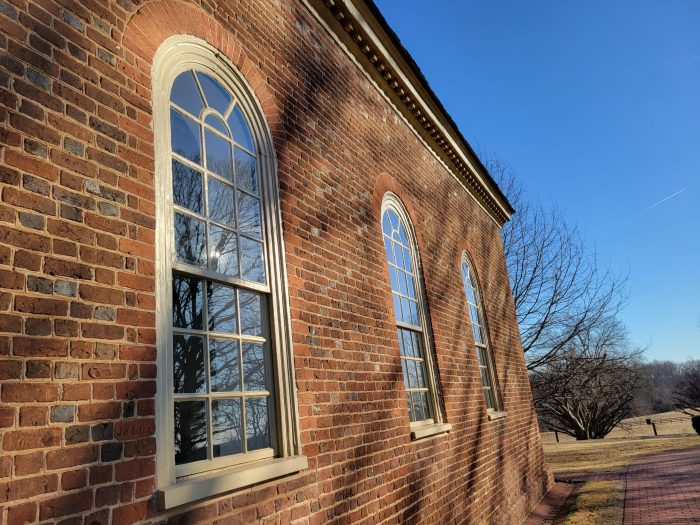ECW Weekender: Little Fork Episcopal Church

The brick structure of Little Fork Episcopal Church would turn the head of any history buff wandering on the backroads southwest of Warrenton, Virginia. The architecture proclaims its long-standing history and begs investigation. (The Civil War Trails sign also is a giveaway that something happened here.)
Standing in the churchyard, the silence—broken by the whispered hints of coming spring—offers that reverential air for reflection. Here, with a church built during the Revolutionary War in the background, the Little Fork Rangers (later Company D of the 4th Virginia Cavalry) mustered in the spring of 1861, preparing to go to war. A couple of years later during the winter of 1863-1864, horsemen in blue from the 17th Pennsylvania Cavalry camped in the churchyard, adding another layer of history and destruction to the scene.
This site has been a meeting place for religious worship since the 1730’s, when this part of Virginia was still frontier in the British colony. The name “Little Fork” comes from the nearby fork in the Hazel and Rappahannock Rivers. Between the years 1773 and 1776, this large brick church was constructed. It remains a place of active worship to this day.
Military tradition surrounded the church, even before the Civil War. Many of the men from the Little Fork region volunteered to serve the American cause during the Revolutionary War, forming part of the Culpeper Minute Men. Their stories and the concept of local militia units paved the way for later local generations to assemble at the churchyard for military purposes. In a rural community, churches and churchyards often served as a gathering place, and should not be automatically interpreted as a blurring of the lines between church (religiously speaking) and state (local militia unit). Religion played a significant role in the lives and beliefs of Americans in the mid-19th Century, but in this situation, the church served as the logical meeting place, rather than an intentionally-chosen symbol for religious devotion. The history for the Little Fork Rangers gives no indication that formal religious services constituted part of their training days; rather the opposite seems to be implied since the gathering days were usually held on Saturdays to avoid interfering with religious services on Sundays.
According to the veterans’ history of the Little Fork Rangers, the unit formed as a militia company during the summer of 1860.[1] September 1, 1860 seems to be the date when the full unit assembled for the first time at “Oakshade Church.”
“The company was organized in St. Mark’s Parish at Oakshade, one of the oldest churches in the Country… The brick in this church are said to have been brought over from England. Dr. Robert E. Utterback was elected Captain; William A. Hill, a cousin of General A.P. Hill, was elected 1st Lieutenant; George T. Freeman 2nd Lieutenant; and Alfred C. Jennings 3rd Lieutenant. The 2nd Lieutenant was a brother-in-law of the Captain, and the 3rd Lieutenant was a brother-in-law of the 1st Lieutenant. There were approximately sixty members of the company, ranging in ages from mere youths to married men with families. There was hardly a house in the Little Fork that was not represented.”[2]
During their summer and autumn of “drills,” the Rangers met at various locations through their community, but Oakshade’s churchyard routinely ranked among the favorites. The drilling days turned into social events, with “great crowds of people [turning] out to witness the company drills.”[3] The uniforms of these militia members must have been a sight!
“The first uniforms of the Little Forkers were beautiful and conspicuous – red, white, blue, and yellow. They would have furnished a splendid target for Yankee bullets, had they worn them into battle, but fortunately they did not. Blue caps, red cutaway jackets with yellow stripes across the front, and white trousers constituted their brilliant make-up. The yellow stripes designated their branch of service – cavalry. This was their uniform during the summer and fall of 1860. During the winter and early spring of 1861, they wore black trousers with a red stripe down the seam. When Virginia seceded, steps were taken to provide gray uniforms for the company. Money was raised by private subscription at Oakshade for this purpose.”[4]
As for weapons, “some had shotguns and some had pistols. All had obtained sabres… The latter weapon was all that many had, and the condition of the company in regard to weapons was poor… In fact, at no time during the war was the entire company well armed.”[5]
Virginia passed an ordinance of secession on April 17, 1861, followed by the state governor calling volunteers into state service. Following the state’s referendum on secession, mustering and recruiting increased. “In the latter part of May, the order came to the Little Fork Rangers to prepare for active service. The company was drilling at Oakshade when the order came, and the courier who brought it rode his horse so hard that he almost killed it.”
“On Saturday, May 25, 1861, all those who had been drilling met at Oakshade and were formed in line. Captain Utterback announced that they had met to enroll for active service in the Provisional Army, adding that if any wished to withdraw, they must do so then. A few did withdraw, but most of them enlisted. Including officers and privates, a total of fifty-four men signed up. After the formalities of enrolling were completed, the company proceeded to Jeffersonton….[then proceeded]….to Camp Henry, Culpeper C.H. on the following Monday, to be mustered into Confederate service.”[6]
The Little Fork Rangers became Company D of the 4th Virginia Cavalry, which regiment saw service from the Virginia Peninsula to the Shenandoah Valley.
The departure of the drillmasters, eager volunteers, and impressionable civilians did not mark the end of war for Little Fork Episcopal Church at “Oakshade.” At some point during the Civil War, the structure came under artillery fire and evidence of cannonball damage still exists in the church’s attic. More destruction occurred during the winter of 1863-1864. The encamped troopers of the 17th Pennsylvania Cavalry shivered through the winter and struggled with the lack of firewood and still-standing trees. (The Civil War deforested huge areas of Virginia as the armies cut trees for cabins and firewood.) The 1776 pews and pulpit became casualties of war and fuel for the cavalrymen’s fires. Despite the damage and the surroundings of war, the historic church itself survived the conflict. Interestingly, Lieutenant David G. Bruce of the 17th Pennsylvania Cavalry gifted $100 to the congregation after the way to aid with repairs to the sanctuary.

Time passed, but one another layer of Civil War history was added to the site in 1904. On May 25, veterans of the Little Fork Rangers gathered with their families to dedicate a unit monument. “The monument is of white marble, granite base, fifteen feet high. On its summit stands a Southern woman wreathed in laurels, bearing the saber.”[7] The four sides of the monument bear inscriptions, a verse of poetry, a carved relief of a young cavalryman, and the names of the company members. Thirty-seven veterans of the unit gathered for dedication which included speeches and Lost Cause pageantry; the ceremony also included religious observances in their memorializing, including prayers and hymns, and invoked a more religious atmosphere in the churchyard than seems to have been observed in 1860-1861 activities. At the end of the event, a photographer made an image of the veterans and their memorial.

Today, Little Fork Episcopal Church is preserved and named on the National Register of Historic Places. An active congregation still gathers for worship on Sundays. A Civil War Trails sign sits at the edge of the churchyard green, not far from the veterans’ monument. On a quiet morning with an overactive imagination, it is possible to vividly add enthusiastic cavalry militia to the scene or catch an echo of columned cavalry departing their winter quarters for the spring campaign. The site offers layers of local, militia, and Civil War history, and a chance to ponder how a historic church served as a gathering place for a rural community in their road to war and their efforts to memorialize.
To visit Little Fork Episcopal Church, use this address: 16461 Oak Shade Rd, Rixeyville, VA 22737. The nearby main road is VA-229/Rixeyville Road, and it is about 5.8 miles south of the VA-211/VA-229 Intersection which is west of Warrenton.
Sources:
Little Fork Episcopal Church: https://www.littleforkchurch.org/history/
[1] Woodford B. Hackley, The Little Fork Rangers, 1927. Accessed through Google Books. Page 25.
[2] Ibid., Page 25.
[3] Ibid., Page 26.
[4] Ibid., Page 26-27.
[5] Ibid., Page 28.
[6] Ibid., Page 28.
[7] Ibid., Page 105.



Interesting. Question – exactly what is a “3rd Lieutenant”? I have seen that reference before, and heard differing explanations.
Mr. Timberlake wasn’t even in the army. He was an old man at home being looted by Yankees. The church let the Rangers use their drill fields and the area is referred to as “Little Fork” because it is between the fork of the Hazel and Rappahannock River. The Church was called Oakshade at the time and only later took the name little fork years later.
The Timbrerlake household was actually the Rixey household and there were no Rixey’s on on the unit. Oddly enough however, after the war Richard Lewis of company H of the the 4th VA Blackhorse Cavalry out of Warrenton and eventually recruited by Mosby ended up marrying his 1st cousin who was a Rixey and he became the owner of PLeasant Hill as Well as Rosedale across the street.
I am probably the 1 person alive that actually knows this entire story and you may be the only other person that has actually been interested in itl. lol I have been boring friends and family with this for years!